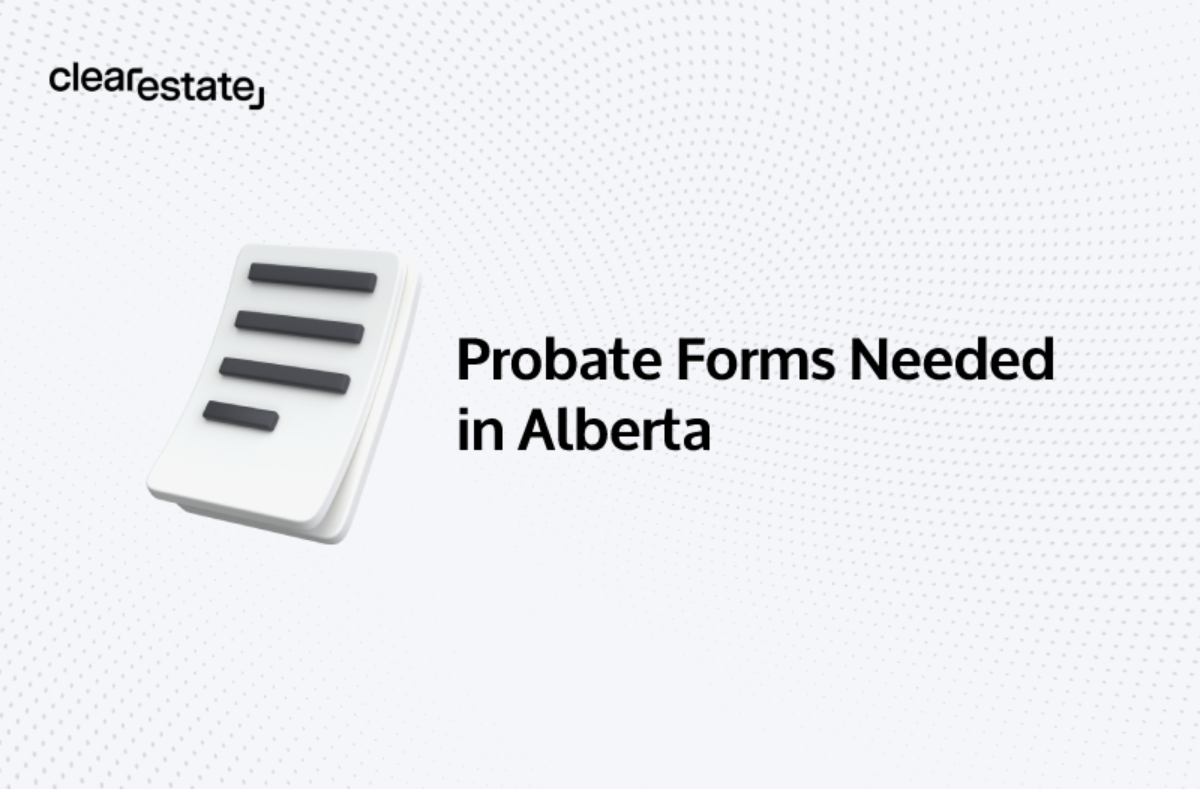Estate Settlement
Dec 04, 2024
How Do Executors Mail Inheritance Checks?
Find out how inheritance checks are mailed, including security measures and what to do if there are delays in receiving them.
Discover the essential probate forms Alberta requires in 2025. A complete guide to navigating what probate forms are needed in Alberta.


When handling estates in Alberta, it's crucial to stay updated with the latest procedures. As of June 15th, 2022, Alberta has taken a fresh approach.
The province rolled out new GA forms, aiming to make the grant application process smoother and more user-friendly.
In this post, we'll dive deep into these new forms, giving you a clear picture of what they entail and how they impact the estate management landscape in Alberta.
| Form ID | Form Title | Usage Scenario | Court Submission? |
|---|---|---|---|
| GA1 | Grant Application | Used to apply for the grant. | Yes |
| GA2 | Inventory | Lists the estate assets and liabilities. | Yes |
| GA3 | Notice to Beneficiaries and Other Interested Parties | Notify each beneficiary and certain other interested parties. | Yes – as an exhibit to Form GA5 proving service of the notice |
| GA4 | Notice to Public Trustee | Notify the Public Trustee if certain individuals have interest in the estate. | Yes – as an exhibit to Form GA5 proving service of the notice |
| GA5 | Affidavit of Service | Affirms service of notices on required recipients. | Yes – within 30 days after the service is complete |
| GA7 | Notice of Grant Issuing | Notify individuals that the court issued the grant. | No |
| GA8 | Affidavit of Witness to a Will | Used when a formal Will has a witness who attests to its signing. | Yes – if applicable |
| GA9 | Affidavit of Handwriting | Attests that a holograph Will is in the deceased's handwriting. | Yes – if applicable |
| GA10 | Affidavit Verifying Translation of a Non-English Will | For non-English Wills; a translator affirms the translation and attaches both versions. | Yes – if applicable |
| GA11 | Renunciation | For those with priority who decline to act as the Personal Representative. | Yes – if applicable |
| GA12 | Reservation of Right to Apply for a Grant | Used by a named Personal Representative who wishes to postpone estate administration but reserve their right for a future grant application. | Yes – if applicable |
| GA13 | Nomination | For a person entitled to act as a Personal Representative but wishes to nominate someone else. | Yes – if applicable |
| GA14 | Beneficiary’s Consent to Waive or Reduce Bond | Used when non-residents seek consent to waive/reduce the bond or security requirement. | Yes – if applicable |
| GA15 | Notice to Creditors and Claimants | Template for publishing a notice to claimants in newspapers. | No |
| GA16 | Statutory Declaration of Publication | Affirms publication of notice to claimants and attaches newspaper notices. | Yes |
| GA17 | Statutory Declaration by Creditors and Claimants | Allows a creditor/claimant to verify their claim against the estate. | No |
| GA18 | Renunciation of Trusteeship | Used by a designated trustee who wishes to decline their trusteeship. | No |
| GA20 | Affidavit of Trustee | Acknowledgement by a trustee of their position in relation to the Will or another authorized appointee. | No |
At first glance, the sheer number of forms might seem daunting. However, Alberta has streamlined the probate application process commendably. The new form system not only simplifies the procedure but also makes filing a petition for probate much more straightforward.
To help you navigate, here are the most commonly used forms when filing for probate:
Let's take a closer look at these forms:
To accurately see and edit the probate forms, your computer/device is required to have Adobe Acrobat compatibility (which is free)
The Grant Application, known as Form GA1, consolidates details previously found in various NC forms. Designed with clarity in mind, it's divided into five distinct sections:
1. Details of the Deceased:
In this section, applicants are required to furnish comprehensive details about the deceased. This includes their full legal name, any aliases, date of birth, date of death, and their last known address.
2. Information about the Applicant(s):
This segment delves into the applicant's credentials and their legitimacy in applying for the grant. Depending on the presence (or absence) of a will, the applicant's authority might be derived from the will itself or the stipulations of the Estate Administration Act.
Key documents like:
Furthermore, any documents mentioned in the will, such as matrimonial agreements or specific distribution lists, should be included.
3. Notification Requirements:
Here, the applicant lists out all beneficiaries, providing their names, contact details, and a brief on the inheritance they're slated to receive. This section also highlights individuals who might stake a claim against the estate. This could range from spouses not inheriting the entirety of the estate, minors, disabled adult children, or even individuals whose whereabouts are unknown.
4. Court Documentation:
The court mandates the inclusion of specific documents.
These encompass:
A recent addition requires applicants to submit proof of the deceased's passing, which can be a Death Certificate or a Funeral Director's Statement of Death.
5. Affirmation by the Applicant:
The Estate Administration Act, coupled with the Surrogate Rules, outlines the duties of an applicant.
Form GA1 reiterates these responsibilities, ensuring applicants are well-informed. They must affirm the authenticity of the information provided, especially concerning the originality of the will or codicil. The applicant acknowledges their understanding of the core tasks listed in the Estate Administration Act and commits to executing them diligently. This includes asset identification, estate management, debt clearance, and proper distribution. The applicant's role demands integrity, adherence to the deceased's wishes (if a will exists), and the prudence expected in fiduciary relationships. They must also ensure timely notifications, accurate updates, and lawful estate distribution.
Form GA2, known as the Inventory form, has undergone significant modifications, especially post-June 15, 2022. Previously, the focus was primarily on assets located within Alberta. The revamped form now demands a broader perspective, capturing:
The form is structured into four main sections:
1. Deceased's Individual Assets:
This section requires a comprehensive listing of assets, irrespective of their location. It encompasses a variety of assets, from tangible ones like land, household items, and personal belongings to financial assets such as bank and investment accounts, company shares, annuities, and life insurance policies.
2. Jointly Owned Assets:
Joint ownership, especially when it doesn't involve a spouse or adult interdependent partner, follows intricate rules established over time. Applicants are expected to list these assets to the best of their knowledge, even if they might not have complete information about all jointly owned assets.
3. Liabilities:
All debts and financial obligations of the deceased as of their passing date need to be detailed in this section.
4. Net Estate Value:
A meticulous calculation is required here. Assets within and outside Alberta should be tallied separately. The net value for the estate in Alberta is derived by summing up the total assets within Alberta and the jointly owned assets that are part of the deceased's estate in Alberta. From this total, the deceased's overall liabilities are subtracted.
A pivotal change to note is the separation of Form GA2 from the primary application, Form GA1. This implies that court clerks no longer scrutinize the Inventory. Instead, the applicant is responsible for serving the Form GA2 Inventory to the residuary beneficiaries (integrated within Form GA3 Notice) and must submit it to the court alongside Form GA5 Affidavit of Service.
Form GA3 serves as a unified notification system, streamlining the process that previously involved multiple notice forms for different beneficiaries. This consolidated form ensures that all beneficiaries and relevant parties are adequately informed. The individuals who must receive this notice include:
1. Beneficiaries:
2. Family Members with Potential Claims:
The design of Form GA3 allows for tailored completion, ensuring that only the sections pertinent to the individual receiving the notice are filled out.
Form GA4 serves as a crucial communication tool, ensuring the Public Trustee is informed when specific individuals have a vested or potential interest in an estate. The form becomes necessary in the following scenarios:
1. Represented Adults: When the Public Trustee is acting as a trustee for a represented adult.
2. Minors: Any minor with an interest in the estate.
3. Missing Persons: Beneficiaries whose whereabouts are unknown.
When completing Form GA4, it's essential to pay close attention to the specific section relevant to each individual. Depending on the situation, you may need to attach additional documents:
It's imperative to ensure that all required forms mentioned in the notice are enclosed. Before serving the notice, make a duplicate. The original should be handed to the intended recipient, while the copy is retained for records.
The primary objective of Form GA4 is to keep the Public Trustee informed, especially when the estate involves minors, missing beneficiaries, or when the Public Trustee has a trustee role for a beneficiary.
Form GA5 plays a pivotal role in the court's oversight process, ensuring that all relevant parties receive the necessary notifications about an application. Here's a breakdown of its significance and usage:
1. Court Oversight:
The court's primary objective is to guarantee that every individual entitled to a notice regarding the application receives it. This is achieved by mandating the applicant to serve Form GA3 to the concerned parties. Subsequently, the applicant must confirm this action by submitting a sworn Form GA5, attesting to the service of the notices.
2. Order of Service and Filing:
Recent modifications to the Surrogate Rules have streamlined the process. Now, applicants must first file the Form GA1 Application with the Court. Following this, they serve Form GA3 Notices to all interested entities. It's crucial to note that the court will only issue a grant once it has received a filed Form GA5 for every concerned party.
3. Service Methods:
Notices can be served either in person or via prepaid registered mail. Once the service is completed, the applicant has a 30-day window to finalize a Form GA5 for each notice and submit it to the court. It's essential to attach a copy of the notice as an exhibit, along with any evidence of service, such as a delivery certificate for mailed items.
4. Exceptions in Notification:
In situations where a specific individual should be notified as per legal requirements but hasn't been, the applicant must address this in part 3.7 of Form GA1. They must provide a rationale for the omission.
Form GA7 is a crucial instrument in the estate administration process, ensuring that all stakeholders are informed once the court has issued a grant. Here's a breakdown of its significance and usage:
Transparency and Communication: The primary objective of Form GA7 is to maintain transparency in the estate administration process. By notifying interested parties that a grant has been issued, it ensures that stakeholders are kept in the loop about significant developments.
Sequence of Notification: Once the court issues a grant, the onus is on the applicant to promptly serve Form GA7 to all relevant parties. This action confirms that the court's decision has been communicated to those with a vested interest in the estate.
Target Audience: Form GA7 is specifically directed towards individuals with potential stakes or claims against the estate. This includes family members like a spouse or adult interdependent partner not inheriting the entire estate, children under 18, and adult children with disabilities affecting their livelihood.
No Court Filing Required: Unlike some other forms, Form GA7 doesn't need to be filed with the court. Its primary purpose is for notification, ensuring that the estate administration process remains transparent and inclusive.
To publish a "Notice to Creditors and Claimants," you should contact a newspaper that is either published or circulated in the area where the deceased lived or where they had property (if they lived outside Alberta).
The notice must be published:
After publishing the notice, you should retain copies of the newspaper containing the notice(s). Some newspapers might even provide you with copies upon request.
To prove that the notice was published, you should complete Form GA16: Statutory Declaration of Publication. This form requires you to declare that you've published the notice and to attach copies of the ad(s) as an exhibit. Some newspapers might complete Form GA16 on your behalf, so it's recommended to check with the newspaper you're using about their specific practices.
Alberta's new grant application process, with its array of GA forms, is a testament to the province's commitment to simplifying estate management. But, let's be real: even with these changes, estate settlement can be a maze.
If you're scratching your head, wondering how to best navigate this process, you're not the only one. We're here to help. Our expertise lies in probate and estate settlement, minus the legal jargon and complications.
Book a free consultation with us. We'll walk you through the steps, ensuring you're on the right track.
 Simplify Probate Today
Simplify Probate Today
Get expert guidance from our probate specialists who've helped 10,000+ families.
Book a free consultation today